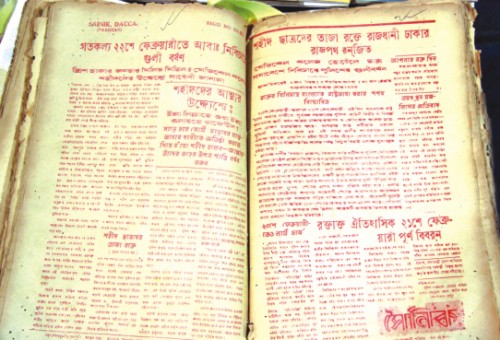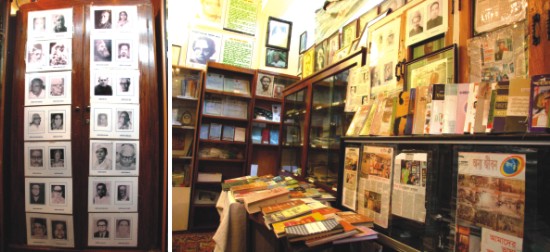|
Endeavour
Preserving The Legacy
Ershad Kamol
Bangla is the only language in the globe that has achieved the status of 'National Language' through a successful movement in 1952, widely known as 'Bhasha Andolan'. Six innocent young men were reported to be killed while many injured and arrested during the movement to establish Bangla as a National Language against the decision of Pakistani government's declaration of Urdu as the only state language of Pakistan. A private organisation named 'Bhasha Andolon Museum' has been preserving, displaying and initiating research works on the legacy of the glorious Language Movement since its inception on June 2, 1989. Recently the museum has set a display at Bhasha Shainik Kazi Golam Mahbub Sarak (former road 10) in Dhanmondi.
The predecessor of Bhashandolon Museum was Bangladesh Bhasha Andolon Museum, which was initiated in 1989 by MA Barnik, a researcher on the Language Movement. At the two display rooms of the museum at Dhanmondi, it features all of the available documents. Twenty-eight photographs, mainly donated by Mohammad Taqiullah, Mohammad Amanul Haque and Professor Rafiqul Islam, feature the Language Movement as a whole from 1948 to 1956. Moreover, it preserves the books, journals and clippings of the newspapers during the movement.

Newspaper clippings of February 1952 preserved at the museum.
Photographs with an ordinary Kodak Folding Film Camera by Mohammad Taqiullah feature the movement from 1948 to 1952. Chairperson of the Museum Committee Peary Mahbub, wife of Kazi Golam Mahboob, the convenor of All-Party Central Language Action Committee in 1952, asserts, "We are grateful to Mohammad Taqiullah, one of the pioneers of “Tamaddun Majlish”, who has donated his photographs of the period as well as the pamphlet named “Pakistaner Rastrabhasha Bangal Na Urdu?” (What is the state language of Pakistan: Bangla or Urdu?) published on September 15, 1947, by the publicity wing of Tamaddun Majlish. The pamphlet features three articles: Amader Prostab (our proposal) by the Mojlish committee, Rashtrabhasha O Purba Pakistaner Bhashsa Shomoshya (state language and dilemma of language in East Pakistan) by Professor Kazi Motahar Hossain and Banglai Amader Rashtrabhasha Hoibe (only Bangla will be our state language) by Abul Mansur Ahmed. This pamphlet laid the ground for the Language Movement. Moreover, we have collected documents, and photographs from the Language Movement veterans as well as clippings of dailies such as Azad and Sainik."
Photographer Amanul Haque and Professor Rafiqul Islam's (the latter was a student at that time) photographs basically feature agitation by the students of All-Party Central Language Action Committee, which was formed with Kazi Golam Mahboob as its convener. Many of these photographs are the only available documents of demonstrations and processions by the students violating Section 144 at the Dhaka University area on February 21, 1952.
Moreover, Amanul Haque has taken a photograph portraying the damaged skull of Shaheed Rafiquddin, a victim of the fateful day. Shah AMS Kibria also had taken same photographs of Shaheed Rafiq's skull, which is also on display at the museum.
Other photographs taken by Amanul Haque and Professor Rafiqul Islam feature incidents from February 1952- 1954 when the then East Bengal Legislative Assembly adopted a resolution recommending the recognition of Bangla as one of the state languages of Pakistan. The Language Movement continued until 1956. Member Adel Uddin Ahmed (1913-1981; Faridpur) made an important amendment proposal, which was adopted unanimously by the Assembly (16 February 1956). Both Bangla and Urdu were thus enacted to be the state languages of Pakistan.
Bhaashandolan Museum does not only display the photographs of the turbulent period, it also exhibits a collage of martyrs of February 21 massacre such as Rafiq Uddin Ahmed, Abdul Jabbar, Shafiqur Rahman, Abul Barkat, Abdus Salam and Ohiullah.
Moreover, portraits and biography of political leaders, student leaders and intellectuals who have made an immense contribution to our Language Movement are also on display. The museum also preserves a copy of “Tamaddun Majlish”, headed by Professor Abul Kashem the book written by the Bengali intellectuals that mobilised the movement.
The research wing of the museum is geared to preserve the historical and other information of the International Mother Language Day as well as to help research fellows on the topic both at home and abroad.
In fact, the research wing is the nucleus of the museum. According to the Director of the Research Wing MR Mahbub, who is also the member secretary of the museum says, “Our aim is not just to display the archival elements. Our aim is to do researches and publish books on the glorious Language Movement. The research centre already comprises of a rich library, archives, documentaries, diaries and the written events of the Language Movement.”
"We have already collected many documents for the research centre and will publish them after a few final touches. As these documents are on the verge of extinction, we are planning to publish an encyclopaedia on Language Movement comprising 2,500 pages. We have published five research papers in this regard.”
Why the name of the organisation is 'museum' rather than 'jaduhgar'? Mahbub replies, “Many people have asked this question. In fact, Museum is a broader connotation than Jadughar. I've already written articles on necessity of using the term museum in Bangla language. Our objective is to explore the facts of the movement, which cannot be expressed properly through the term Jadughar. Which is why many scholars and linguists such as Dr. Syed Anwar Hossain, a professor of Department of History of Dhaka University, suggested us to use the term museum.”

Bhasha Andolon Museum displays photographs of the language heroes as well as the major incidents during the language movement.
Mahbub states that funding is the biggest limitation the organisation is facing right now. "We get the major fund from Language Hero Kazi Golam Mahbub Memorial Trust" he says "which is not sufficient for costly publication works. The venue of the museum is another major problem. So far the museum has shifted its office many times. Now, we are initiating our activities at a temporary office. If we are allotted land from the government, we would be able to preserve the documents of the Language Movement even better.”
Bhasha Andolan Museum is patronised by a private organisation named Language Hero Kazi Golam Mahbub Memorial Trust and run by an executive committee. Activities of the museum fall into six divisions: exhibition, research, documentation, computer and film, publications and library, and administrative. So far, the museum has published ten books including recent four publications, which are available at the ongoing Ekushey Grantha Mela, organised by Bangla Academy. Title of the recently released books is: “Bangla Ki Kore Rashtra Bhashs Holo?” (How Bangla became a state language), “Ekusher Itihashey Prothom” (a book featuring all the firsts of the movement), “Bhasha Andoloner Shargrantha” (a summery of the Language Movement) and “A Short History on Language Movement”.
Copyright
(R) thedailystar.net 2009 |
